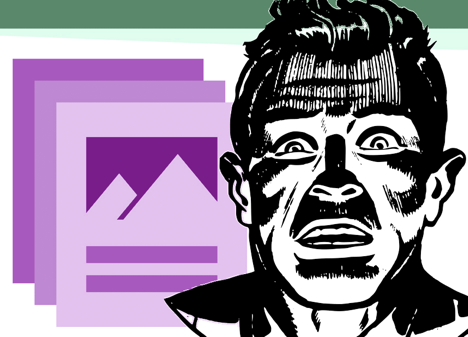Remember the old adage “The Customer is Always Right?”
I learned it at my first job while still in high school, slinging pizzas at a family-owned pizza parlor. If the pizza was sent back to the kitchen for any reason, we put that ticket at the front of the line and replaced it, no questions asked. That lessons stuck with me; and yet with pizzas, it wasn’t too complicated.
Designing digital experiences, on the other hand, is complicated; and with the ever-changing technical landscape, the complexities seem to grow daily. However, the underlying principles I learned at the pizza parlor so many years ago still apply.
Actions speak louder than words
Today I’m not dealing face-to-face with customers while serving up their pizzas one-at-a-time. I’m working with project teams who design experiences that need to work well for thousands, if not millions of people. My teams use data to better understand and bring those customers to life, and we have more data than ever before. The data tells us what the customers say and what they do.
So now, in addition to saying the customer is always right, we get to ask what it is they’re right about. Are they right about what they say they want, or what they actually do? Both are important, but when these two aspects of the customer’s behavior contradict each other, we have to recognize what’s happening, and help our teams forward by providing a credible rationale for taking one path over another.
When the customer’s actions tell us one thing and their words tell us another, it’s time to call upon the data tools in our toolbox. We need to provide not just opinion, but empirical evidence that supports the proposed UX strategy.
Deeper insights drive greater success
Using data to understand and validate user behavior patterns helps my teams design more effective experiences. Data places us firmly on the side of what our customers are actually doing, and that’s more important than what they say they want. I’ll explain.
Let’s imagine we’re on a project and the team is well-versed in user-centered practices. As UX leaders, we understand that one role we play is to advocate for the user; the idea that because users are physically absent from the design process, we have to be their voice at the table.
Our discipline has given us techniques to bring that customer to life. Among these are personas, which represent archetypal users, and customer journey maps, which put a persona into a scenario in order to map wants, needs, and desires. Using these techniques, the team stands a much better chance of aligning around what’s going on in the customer’s head.
Hopefully your personas and customer journey maps have been informed by real data and developed as part of a collaboration with the entire project team, including business stakeholders. In my current position, leading UX for a top digital agency that pioneered Big Data, the personas and customer journey maps my teams create are based on insights revealed by a deep understanding of online and offline behaviors.
Why does data matter to UX?
These days we talk about Big Data a lot, perhaps without understanding it entirely. Big Data has changed the customer experience, and because of this it is changing how UX designers view customers. We are still committed to user-centricity–believing that the customer is always right–however, we can now use data science to look deeply at what people do online. We can find new patterns that were previously hidden and access information which opens doors to user experiences that are more personal and engaging than ever before.
We have a ton of data on users, we just have to figure out what to do with it.
Fundamentally, we’re looking for relevancy and meaning. My company processes and analyzes online behavior using teams of people or programs and machines. But no matter how the data is processed, the end goal is to better understand people and their behaviors. Specifically, how what people are doing today points to what their wants, needs, and desires will be tomorrow.
Once we understand what users will be looking for, we’re in a much better position to strategically design and provide the right content or interaction at the right time. Done well, we improve the customers’ overall effectiveness, and we meet our clients’ business goals.
Here’s an example
On the project team, one side of the equation–what the customers say they want–may be weighted more heavily. That makes sense: most of us want to please people, so giving them what they say they want seems straightforward. Yet being a pragmatist, I find often myself trying to answer the other question: What is it they actually do?
Let’s take a hypothetical example. Our persona, Roberta likes things that are new and different. She’s smart and technically savvy, and because she’s designed her own website, she knows a thing or two about web design. Roberta likes things that are cutting edge, so if she doesn’t feel your client is forward-thinking, she’ll probably just click off and keep looking somewhere else.
The client loves Roberta because they too want their site to be exciting, new, and different. The account team (whose customer, after all is the Client) always wants to say yes; to demonstrate their willingness to push the envelope and leave the competition in the dust. Likewise, the creative team can’t wait to flex their muscles, so it seems like everyone’s aligned, right? Everyone wants to create a stunning masterpiece that’s new, different, and exciting.
The only problem is that user behavior patterns do not typically change. User behavior patterns are predictable things people do. They underpin web heuristic analyses–those checklist evaluations that tell you if your website is usable or not. They’re also evidenced by the data if you know where to look.
Data and user behavior patterns
Scanning rather than reading is a user behavior pattern. Searching for content, scanning the page in an F-pattern, looking to the top left for a menu or Home button; these are just a few common user behavior patterns. All these plus many more need to be taken into account. Patterns matter because they help us more fluidly interact with a system. They indicate what users actually do which allows us to ask, “Are they doing what we want them to do?”
Web usability guru Jakob Nielsen notes that users spend most of their time on other sites. Because of this, one user behavior pattern is looking for critical items in the top-left portion of the screen.
Add to this well-known pattern new data insights that allow us to discern more subtle behavior patterns. For instance, machine learning can spot patterns that humans might not see. Data, big and small is changing experience design, and heuristics alone are no longer the end goal, they are the stepping-off point.
We now have many, many tools to analyze how our experiences succeed or fail in meeting our user’s needs. Our project goals such as customer acquisition, retention, growth, and so on, bump up against the reality that our thousands and millions of users are at different points of their customer journey at different times. This is part of the complexity I hinted at earlier, and data can tell us if the experiences we’ve designed are meeting those dynamic business objectives or not.
Something as simple as the placement of a menu can have huge ramifications. The creative team may see left-side navigation as stale and boring, yet your studies may show that this is exactly where it needs to go. So, think of the various tools you can use to avoid a subjective discussion full of unfounded opinion: make a prototype, do an eye-tracking usability study or an A/B test. Gather the data and see what the user is actually doing!
Eye tracking will show you if users are failing to find what they’re looking for in the expected area. An A/B test will show you which call-to-action is better. That’s data you can take back to your team. That gives you rationale to say, “This design is confusing to our users (data) and a confused user is one who is more likely to bounce (data).”
In our hypothetical example, even though Roberta said she wanted something new and different, her behavior as measured by what users like her actually do may indicate otherwise.
Another example: Maybe your analytics show that users are searching for critical content rather than finding it by clicking on the button you’ve placed in what you thought was a prominent position. What does this analytic tell you? Perhaps the button isn’t where your users expect it to be.
Always be closing–the gap between you and your users
We can debate what it is our users might be looking for or why; and we absolutely must continually analyze and re-analyze our data for all the creative insights we can extract. These insights can drive powerful content strategies that ultimately help put our clients miles ahead of their competitors. That’s what we’re paid to do–and yet it won’t work if the user can’t find what they’re looking for.
That’s why we need to always check the data, and never lose sight of the basics. It’s easy to fall into the trap of thinking we can force user behavior patterns to change, but to validate our assumptions we have to always go back to what users actually do. We can see what they do by running tests, studying analytics, and analyzing data, or yes, even asking them.
As a UX leader, you need to be familiar with all the ways data helps teach you about your users. You have to be knowledgeable about what they’re doing today to understand what they’re likely to need, want, or desire tomorrow. You’ll still be advocating for the user, but it will be less about what they say and more about what they do.
Because no matter what, you have to make sure to put the sauce on before the cheese, and remember that the pepperoni always goes on top. You have to do that because that’s what the customer expects. It’s what they do, and The Customer is Always Right.



